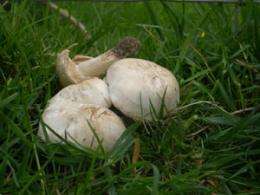(PhysOrg.com) -- Scientists have discovered that spring-fruiting fungi, including the morel and St George’s mushroom are fruiting nearly three weeks earlier than they did 50 years ago.
The study, carried out by an international team of scientists, including a biologist from Royal Holloway, University of London, examines the changes in the time of spring fruiting in Norway and the UK between 1960 - 2007.
The findings are being published in the 'Proceedings of the Royal Society' this week and show not only how global warming has lead to the earlier fruiting of spring fungi but that climate affects the growth of organisms over much longer time scales than previously thought.
Alan Gange, Professor of Microbial Ecology, at Royal Holloway, says, “It is well known that organisms such as birds or plants are laying or flowering earlier, due to higher prevailing temperatures in the spring. However, we found that higher temperatures as long ago as the previous summer cause fungi to fruit earlier in the following spring.”
These findings show the effects of climate change have an impact over longer periods than previously believed. “Even if we do manage to reverse climate change the effects will last longer than we previously thought, so the climate today could affect the growth of mushrooms in 18 months time”, he said.
Many fungus species spend their lives in the soil as a fibrous mat called a mycelium. Professor Gange believes the fungi used to be kept in check by sharp frosts earlier in the year but the lack of these frosts has meant nothing is forcing the fungi to remain dormant in the soil and so they appear earlier.
Professor Gange said, “The entire pattern of fungal growth has changed, meaning that the vital ecosystem functions of decomposition and nutrient cycling must have speeded up considerably, as our autumns and winters have become warmer”.
“This means the disappearance of leaf litter and rotting of things like compost heaps happen more quickly than they used to. In woodlands tree growth is likely to be quicker because of greater availability of nutrients.”
Despite the contrasting climates of the UK and Norway the results were consistent between both countries because both climates have experienced warming over the winter.
Provided by Royal Holloway, University of London


















